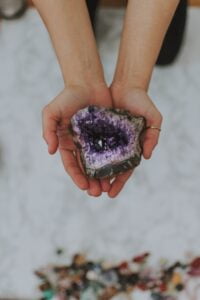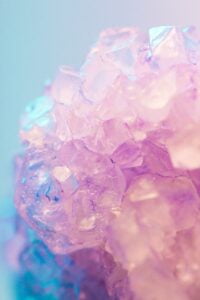What Is The Rarest Crystal?
What Is The Rarest Crystal? You’re about to embark on a mesmerizing journey to uncover the rarest crystal on Earth. Prepare to be dazzled by the intricate details, unique qualities, and astounding beauty of this extraordinary gem. This gem isn’t just rare, it’s the ultimate in scarcity, making it a true symbol of rarity in the captivating world of crystals. Let’s learn all there is to know about this exceptional treasure.

Understanding Crystals and Their Rarity
Understanding crystals and their rarity requires a deep dive into the world of geology and gemology. These beautiful and intriguing structures are more than just sparkly decorations; they hold a wealth of history and science within their brilliant facets.
Definition of Crystals
A crystal is a type of solid material in which the constituent atoms, molecules, or ions are arranged in an orderly repeating pattern extending in all three spatial dimensions. This unique arrangement is what gives crystals their distinct shape and symmetry, flashing with brilliance when they come into contact with light. Crystals have been admired for their beauty, but they’ve also played crucial roles in technological and industrial advances.
Factors determining the rarity of Crystals
Several factors determine the rarity of crystals. These factors include how often they occur in nature, the difficulty of extracting them, their demand in the market, their unique characteristics, and their price per carat. Exploring these factors reveals why some crystals are deemed as rarer than others.
Criteria for a Crystal to be Considered Rarest
For a crystal to be considered the rarest, there are specific criteria that it must meet. Let’s delve deeper into these criteria:
Availability and location
A crucial determinant of a crystal’s rarity is its availability and the locations it can be found. Some crystals are only discovered in specific geographic regions due to the unique geological conditions of those areas. If a crystal can only be found in one specific area, it is considered rarer than those which are widely distributed.
Extraction difficulty
Another criteria is the difficulty of extraction. Some crystals can be easily extracted from the earth’s crust, making them less rare. In contrast, others are found deep within the earth or in hard-to-reach locations which makes their extraction process much more challenging and hence, rarer.
Market demand
The market demand for a crystal also affects its rarity. If a crystal is in high demand but is supplied in limited quantities, it will be considered a rare item. High demand can stem from aesthetic appeal, symbolic or cultural significance, or industrial applications.
Uniqueness
The uniqueness, or specific characteristics exclusive to a crystal, also contributes to its rarity. This can include the crystal’s color, clarity, size, or the presence of unusual features, which make it stand out.
Price per carat
Lastly, the price per carat is a significant determinant of rarity. Higher prices are usually linked to the rarer crystals as they are less common, more beautiful, or harder to extract.
Historical Records of Rare Crystals
Historically, rare crystals have garnered admiration, intrigue, and a fair bit of competition for their collection and ownership.
Significant Discovery of Rare Crystals
There have been many significant discoveries of rare crystals in history, adding to our knowledge and fascination for these glimmering wonders. For instance, the discovery of the Hope Diamond, a rare blue diamond and the Cullinan diamond, the largest gem-quality diamond ever found, made news worldwide due to their sheer size, beauty, and value.
Rarest Crystals in Various Cultures and Their Significance
Rare crystals hold a special place in various cultures, symbolizing wealth, power or spiritual significance. For instance, diamonds are highly valued in Western cultures as a symbol of eternal love. Meanwhile, jade is revered in many Asian cultures for its believed spiritual and healing properties.
Rarest Crystal Species
There are numerous crystal species across the world, but some stand out for their exceptional rarity.
Pink Star Diamond
The Pink Star Diamond is considered one of the rarest crystals in the world. It has a unique and stunning pink color with impeccable clarity that is very rare for a diamond of its size.
Taaffeite
Taaffeite, typically a lovely pastel mauve or pink, is almost never found and was mistaken for spinel until gemologist Richard Taaffe discovered otherwise – hence its name. Its rarity and lovely appearance make it highly prized among gemstone connoisseurs.
Blue Garnet
Blue Garnet is another extremely rare crystal. Most people think of garnets as being red, but this variety changes colors based on the lighting and can appear blue-green in daylight but reddish-purple under incandescent light.
Grandidierite
Grandidierite, characterized by its blue-green or translucent green color, is an extremely rare and precious mineral. Found in Madagascar, its unique bluish-green color is prized by collectors.
Serendibite
Serendibite is a borosilicate mineral, initially discovered in Sri Lanka (formerly known as Serendib, hence the name). It is one of the rarest gemstones in the world, characterized by its deep blue color.

Rarest Crystals and their Market Value
The rarity of a crystal is inherently linked to its market value, influencing several aspects of its economic relevance.
How Rarity Impacts Price
Rarity often translates to a higher price in the market. As demand exceeds supply for these rare crystals, prices inflate. Also, the intrinsic value from the unique characteristics of rare crystals, such as their color, quality, and beauty, increases their price tags.
Market Trends for Rare Crystals
Market trends for rare crystals often fluctuate based on factors like fashion trends, cultural shifts, economic conditions, and technological advancements. However, as long as there is a demand for rare gems in jewelry, technology, or as investments, they will continue to hold considerable market value.
Influence of Rarity on Investment
Rare crystals can be excellent investments. Due to their scarcity and continuous demand, the value of these crystals tends to appreciate over time. Investors and collectors often seek out rare crystals as a form of wealth preservation or to sell when prices peak.
Scientific Methods to Identify Rare Crystals
There are various scientific methods employed to identify and confirm the rarity of crystals.
Use of Technology for Identification
Tech advancements have made it possible to identify the structure, compositions, and origin of crystals with remarkable precision. Techniques like Raman spectroscopy, electron microscopy, or X-ray diffraction are commonly used. https://gemologyonline.com/
Processes in Lab Testing of Crystals
Once a crystal is extracted, it undergoes rigorous lab testing to confirm its identity and evaluate its quality. These tests can include visual inspections, microscopic examinations, chemical analysis, or other specific tests to determine a crystal’s physical and optical properties.

Rarest Crystal Jewelry
Some of the world’s rarest crystals have been used to create exquisite pieces of jewelry.
Famous Crystal Jewelry pieces
Famous jewelry pieces, such as the Hope Diamond necklace, the Cullinan Diamond in the British Crown Jewels, or the Pink Star Diamond ring, have made headlines due to their magnificent beauty, size, value, and the rare crystals that form their centerpiece.
How Crystal Jewelry is Valued
While the rarity of a crystal contributes significantly to a crystal jewelry piece’s value, other factors like the craftsmanship, design, historical significance, or ownership by notable personalities can influence its market value.
Celebrities Wearing Rare Crystal Jewelry
From the red carpet to royal weddings, rare crystal jewelry has always been a favorite among celebrities. The cost, exclusivity, and allure contribute to the appeal of these show-stopping pieces.
Rarest Crystals in Museums
Rare crystals have a special place in museums worldwide, where they can be admired, studied, and appreciated by audiences of all ages and backgrounds.
Museums Exhibiting Rare Crystals
Several renowned museums, such as the Smithsonian Natural History Museum, the Natural History Museum in London, and the Mineral Museum in Russia, house extensive collections of rare crystals, offering visitors a chance to witness their splendor first-hand.
Importance of These Exhibits
These exhibits are crucial educational tools for both the public and scientists. They offer a unique glimpse into the earth’s geological processes, the history of mining, and the role of crystals in cultures and economies globally.
Curation and Maintenance of Crystal Exhibits
The curation and maintenance of rare crystal exhibits require considerable expertise and care. Proper lighting, temperature, and humidity control are essential to preserve the crystals’ quality and protect them from damage.

Threat to the Rarity of Crystals
Despite their beauty and value, the rarity of crystals is under threat due to various factors.
Over-Mining Risks
Over-mining is a significant threat to the rarity of crystals. As mines are exhausted, the availability of these gems decreases, pushing their rarity and price.
Synthetic Gemstones Reducing Rarity
Technological advancements have enabled the production of synthetic gemstones that mimic the properties of rare crystals. While beneficial in some respects, it reduces the perceived rarity of naturally occurring crystals.
Climate Change and Environmental Impact
Climate change and other environmental factors also present threats to crystal rarity. Changes in the earth’s structure, weather patterns, and ecosystems can adversely affect the formation and accessibility of crystals.
Future of Rare Crystals
While the threats are real, the future of rare crystals still holds much promise, thanks to continuous exploration and technological advancements.
Exploration of New Geographies for Mining
As known mines are depleted, exploration in uncharted territories and under oceans could unravel new sources of rare crystals, keeping the market dynamic.
Innovation in Crystal Cultivation
Innovations in lab-grown or synthetic crystals have also emerged as a promising alternative to naturally occurring ones. These cultivated crystals could satisfy the market demand without depleting natural resources.
Potential Uses of Rare Crystals in Technology
The potential uses of rare crystals are not limited to jewelry. With their unique properties, they might hold the key to advancements in various fields like technology and medicine.
Understanding the rarity of crystals and what drives it is filled with intrigue and lessons about our planet’s geology, cultures, and economies. As we continue to discover, innovate and appreciate these beautiful gems, we’re reminded of nature’s incredible wonder.

